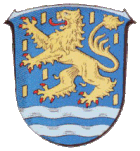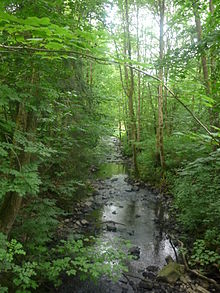Nisterau
| coat of arms | Germany map | |
|---|---|---|

|
Coordinates: 50 ° 40 ′ N , 8 ° 0 ′ E |
|
| Basic data | ||
| State : | Rhineland-Palatinate | |
| County : | Westerwaldkreis | |
| Association municipality : | Bad Marienberg (Westerwald) | |
| Height : | 500 m above sea level NHN | |
| Area : | 3.26 km 2 | |
| Residents: | 821 (Dec. 31, 2019) | |
| Population density : | 252 inhabitants per km 2 | |
| Postal code : | 56472 | |
| Area code : | 02661 | |
| License plate : | WW | |
| Community key : | 07 1 43 277 | |
| LOCODE : | DE NRX | |
| Community structure: | 2 districts | |
| Association administration address: | Kirburger Strasse 4 56470 Bad Marienberg (Westerwald) |
|
| Website : | ||
| Local Mayor : | Markus Schell | |
| Location of the local community Nisterau in the Westerwaldkreis | ||
Nisterau is a municipality in the Westerwaldkreis in Rhineland-Palatinate . It belongs to the Bad Marienberg (Westerwald) community .
geography
The community is located in the Westerwald between Limburg an der Lahn and Siegen . It borders the city of Bad Marienberg in the south, although the residential development is now almost closed. In the north it borders on the municipality of Nisterberg and thus on the Altenkirchen district. The border forms the small nest . The place crosses the federal road 414 (former Cologne-Leipzigerstrasse), which ensures the place a good traffic connection between Herborn and Altenkirchen. The Black Nister flows through the town in the south . The location between Kleiner and Schwarzer Nister was also decisive for the name.
Nisterau consists of the districts of Bach and Pfuhl (dialect: Baach and Pool or Poul .) The Gotthardshof residential area also belongs to the community.
history
Pfuhl was first mentioned around 1300, Bach is mentioned for the first time in 1416. In the early modern period, both places belonged to the county of Nassau-Dillenburg and to the Marienberg office. There was a place between the two places until the Thirty Years' War, but it then became desert. From 1815 the two places were part of the Duchy of Nassau and after 1866 the Prussian province of Hesse-Nassau and its administrative district of Wiesbaden. After the Second World War and the creation of the French occupation zone, the two places were torn out of their old Nassau context and added to the newly created state of Rhineland-Palatinate. First the place belonged to the administrative district of Montabaur, after its dissolution the administrative district of Koblenz. The newly created coat of arms is based on the long affiliation to Nassau.
Today's community Nisterau was formed on June 7, 1969 from the dissolved communities Bach (302 inhabitants) and Pfuhl (391 inhabitants).
- Population development
The development of the population in relation to today's area of the local community Nisterau, the values from 1871 to 1987 are based on censuses:
|
|
religion
The parish belonged to the Marienberg parish as early as the Middle Ages and early modern times. Its denomination was ruled by the Counts of Nassau-Dillenburg, whereby they first switched to Lutheranism in the 16th century and then changed to the Reformed faith under Count Johann VI, the brother of Wilhelm of Orange, from the 1670s onwards. The Protestant religion remained completely dominant into the 20th century, but in the late 19th century a numerically not inconsiderable Free Church community split off. It also has its own meeting place here. After the Second World War, this picture changed with the influx of Catholics.
Today 54% of the residents of the Evangelical Church in Hesse and Nassau (EKHN) belong to, and 15% are Roman Catholics . The members of the Protestant regional church are assigned to the parish IV " Hof " of the Evangelical parish Bad Marienberg , which belongs to the deanery Bad Marienberg in the Propstei Nord-Nassau of the EKHN. The Catholics belong to the parish "Mariae Heimsuchung" in Höhn , Diocese of Limburg . In Nisterau itself there is the aforementioned Free Evangelical Congregation, which is affiliated with the Federation of Free Evangelical Congregations in Germany .
politics
Municipal council
Organized political parties did not form in the two communities during the Second Empire, the Weimar Republic or in the post-war period. However, due to the membership of numerous members of the Communist Party, the community fell out of the ordinary.
The council in Nisterau consists of twelve council members, who in the local elections on May 26, 2019 in a majority vote were elected, and the honorary mayor as chairman.
mayor
Markus Schell became mayor of Nisterau in 2014. In the direct election on May 26, 2019, he was confirmed in office for another five years with a share of the vote of 83.33%.
Schell's predecessor was Friedel Pfeiffer.
coat of arms
A coat of arms was only created when the two communities merged. It was developed during the time of Mayor Emil Weber in collaboration with several officials from the higher archives service in the Marburg State Archive, and therefore not the Koblenz State Archive, which is actually responsible. The description of the coat of arms reads: "In blue two silver wave bars in the base of the shield, above a golden, red-armored and tongued lion between golden shingles."
Based on the colors and the lion, the former affiliation to the county or the Duchy of Nassau can be recognized. In addition, the two waves symbolize the black and the small nest , brooks that also form the natural boundary of the community.
Culture and sights
Monuments
Nature reserve
The former Bacher Lay quarry , now a nature reserve, is located between Nisterau-Bach and Bad Marienberg . The Black Nister flows through the Bacher Lay.
traffic
- The B 414 , which leads from Driedorf -Hohenroth to Altenkirchen , runs in the immediate vicinity of the village .
- The next motorway junction is Haiger / Burbach on the A 45 Dortmund - Hanau , about 20 kilometers away.
- The closest ICE stop is Montabaur train station on the Cologne – Rhein / Main high-speed line .
Famous residents
- Rudolf Held (1911–1987), a SED politician in the GDR , was born in Bach .
- Born in Nisterau was the long-time archivist from Marburg and later Professor Gerhard Menk (1946–2019), who received the Hessian Science Prize in 2005 as an important science, state and constitutional historian.
Web links
- Internet presence of the local community Nisterau
- Local community Nisterau on the website of the Bad Marienberg (Westerwald) community
Individual evidence
- ↑ a b State Statistical Office of Rhineland-Palatinate - population status 2019, districts, municipalities, association communities ( help on this ).
- ↑ Hermann Josef Hucke: Place names in the Westerwaldkreis in their dialect pronunciation as well as Ortneckereien ( Memento from January 9, 2014 in the Internet Archive ) , 2010, page 3 (PDF; 132 kB)
- ↑ State Statistical Office Rhineland-Palatinate (ed.): Official directory of the municipalities and parts of the municipality. Status: January 2019 [ Version 2020 is available. ] . S. 72 (PDF; 3 MB).
- ↑ Official municipality directory 2006 ( Memento from December 22, 2017 in the Internet Archive ) (= State Statistical Office Rhineland-Palatinate [Hrsg.]: Statistical volumes . Volume 393 ). Bad Ems March 2006, p. 190 (PDF; 2.6 MB). Info: An up-to-date directory ( 2016 ) is available, but in the section "Territorial changes - Territorial administrative reform" it does not give any population figures.
- ↑ State Statistical Office Rhineland-Palatinate - regional data
- ↑ census database
- ^ The Regional Returning Officer Rhineland-Palatinate: Local elections 2019, city and municipal council elections
- ↑ Schell's office open to everyone. 49-year-old is the new local manager. In: Current: Nisterau parish. Westerwälder Zeitung, August 28, 2014, accessed on June 4, 2020 .
- ^ The Regional Returning Officer of Rhineland-Palatinate: direct elections 2019. see Bad Marienberg, Verbandsgemeinde, 14th line of results. Retrieved June 4, 2020 .
- ↑ Badge of honor for Jürgen Willwacher from Nisterau. Verbandsgemeinde Bad Marienberg, December 10, 2013, accessed on June 4, 2020 .



